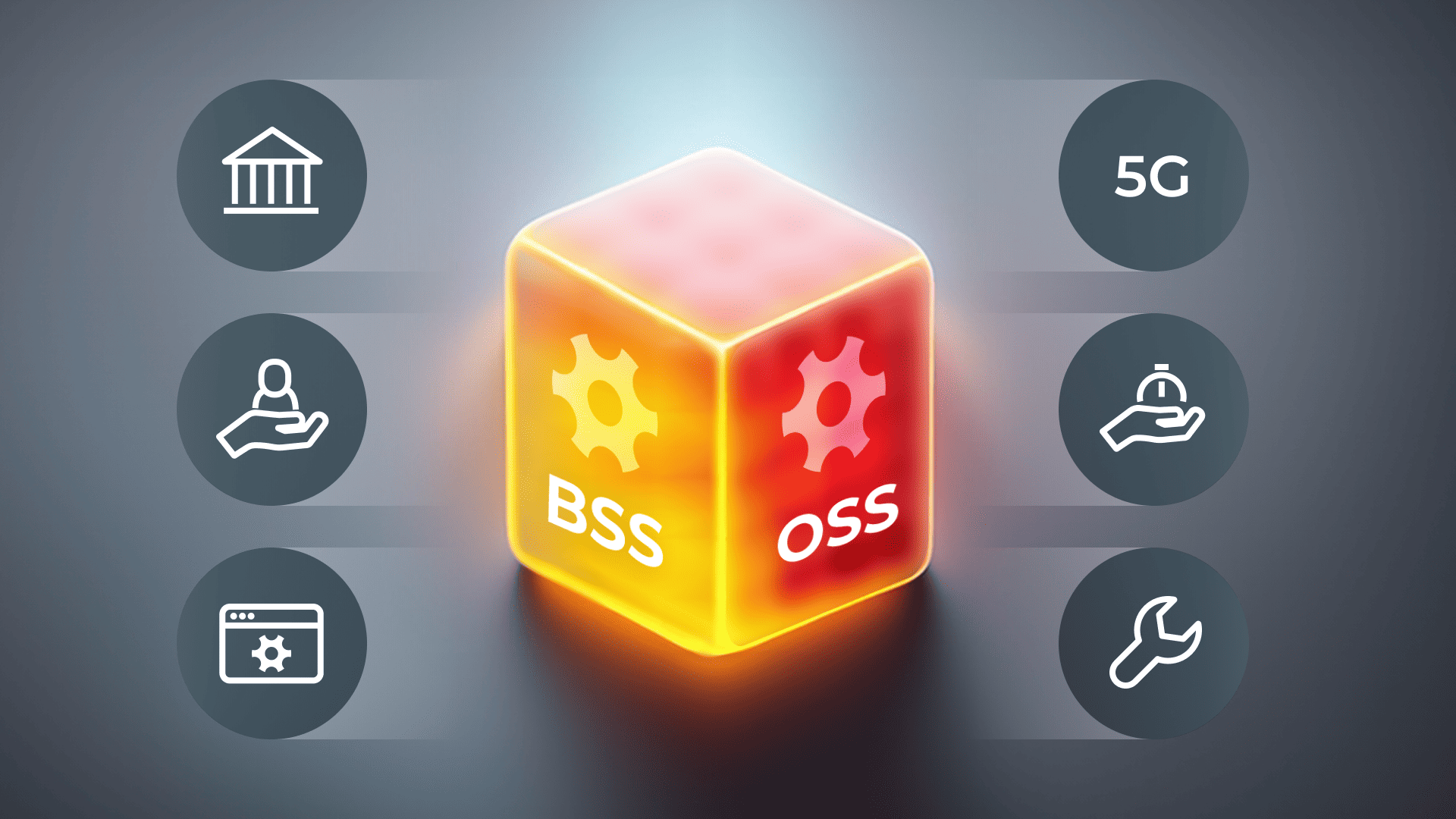Anyone who has spent time wading into the various acronyms and initialisms of the telecom industry will likely have come across two striking sets of letters – namely, that is, BSS and OSS. These two systems are so critical to telecom success today that, together, they might as well be called the B/OSS.
Telecom OSS, BSS, and all the software applications and technologies they comprise are important not just because of the way the name recalls a certain musical celebrity. (Hello, Boss!) They matter because the processes they signify work together to form the backbone of all effective telecommunications operations. And, as you’ll see, of many other operations too.
BSS and OSS in telecom play a pivotal role in delivering top-level customer experiences, and smart telecom operators rely on them to manage their network infrastructure. (And nearly all of their business processes, too.) So, we think it’s definitely time for this blog to tell the story of BSS and OSS.
What Is BSS? What Is OSS? And, for That Matter, What Is Telecom OSS / BSS?
OSS BSS… meaning, well, what? Let’s kick off right away by un-initializing these odd initialisms and answering the top-line question of what is OSS and what is BSS. In full form, BSS stands for business support system, and OSS stands for operations support system.
What’s the difference, you ask? The best way to understand the relationship between these two systems in telecom is to compare them to your own body. The role of BSS is a bit like that of a human brain: it makes the decisions. It’s the job of BSS to decide who is a customer (and who is not), which of those customers need service, how that service should be accomplished, and so on.
OSS, meanwhile, is more like your nervous system. (In other words, what connects your brain to all of your various body parts.) It helps the BSS execute its decisions by taking the actions that the BSS has decided need doing. Using our analogy, again, say for example that your brain (BSS) wants your nose scratched (i.e., it decides it wants a customer account activated). So, your nervous system (OSS) then moves your hand to your nose (i.e., it does the work of activating the account and provisioning the devices).
The Actual Telco Applications of BSS and OSS
Let’s put this in real (non-brain) terms. A telecom’s BSS encompasses a wide range of software applications and platforms that handle all customer-focused operations and generally support the business processes. BSS specifically handles customer transactions, product catalogs, billing, and other critical functions. OSS, meanwhile, comprises the different interconnected software applications that a given telecom operator will use to manage and maintain their network infrastructure. (In short, their operations.) An OSS helps CSPs monitor, control, and optimize their network performance to ensure seamless service delivery to its customers. It also provides CSPs with valuable insights into their network performance, customer behavior, and service quality. That’s all critical stuff that CSPs need in order to refine their service delivery and compete.
More Systems, More Problems
Are you thinking that it must be very complicated to have one or even two applications managing all of those processes? Well, you’re correct. And for that reason it has not always been seamless.
“I was working for Telenor in the early 2000s, when the company was focused mainly on small-business customers. My department was taking care of a BSS system that authorized the service access in real-time,” says Andriy Zhylenko, CEO of PortaOne. “But then Telenor bought another company that was more focused on medium-sized and enterprise-level businesses. They were connected by DSL lines (there was no fiber then) and other dedicated infrastructure. So, for the customer, it was not enough just to know a username and password – it was more complicated. There were all these different settings that had to be activated, both on equipment like routers on the customer side, and also on the gateways and things like that on the telecom’s side. And, of course, the company that was being acquired had their own system for that.”
For years, Andriy explains, this newly amalgamated company had to manage all kinds of separations in its BSS and OSS. That, eventually, led to both technical and personal conflict. “It was not just separated by software function, but also by department and even by geographic location,” he recalls. “There were arguments about interfaces, about how the system should communicate, about programming languages… As you can imagine, it brought some challenges.”
BSS and OSS Integration to the Rescue
Today, thankfully, there is a growing focus on the “system” part of BSS and OSS. In other words, using integration to make sure that all the different software solutions work together. And that means both within a given BSS or OSS instance, and also across the two systems.
And there is even increasing integration across telco businesses too – at least in terms of vision. Organizations like TM Forum are further connecting the communications services industry to help accelerate this move toward integration and open APIs. They’re doing it via think tanks, knowledge sharing, and the creation of a telco-specific Digital Maturity Model that the companies can use to assess their progress and plan a way forward.
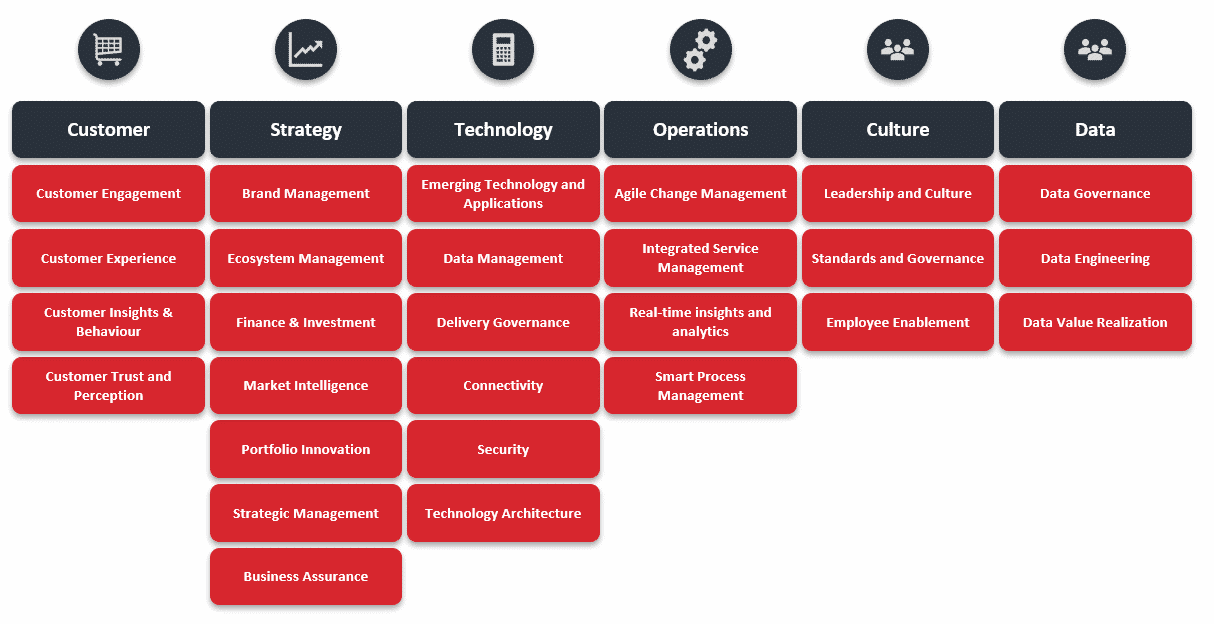
BSS and OSS in Action (AKA What They Actually Do)
So, thanks to all this integration, there is now a lot of overlap across BSS and OSS… at least in terms of what they are actually responsible for. These include charging for services used and then sending a bill for those charges (and handling the payments, too), CRM, fulfillment, product management, managing the telecom network (most of all that on the BSS side), along with inventory, QA processes, et cetera (mostly on the OSS side).
That overlap is only increasing as communications services packages and their delivery become more tailored to the individual customer. Still, it is possible to shake out the roles of BSS and OSS into two more or less distinct columns. So let’s do just that.
The Functions of OSS
Time for a few breakdowns. In the modern telecom industry, OSS has a role in these six general process categories:
- Real-time network monitoring and management to ensure smooth network operations and alert operators to any issues so they can be resolved quickly.
- Fault management to detect and isolate errors in the network. (And, additionally, to help minimize the amount of time an end user can’t access their services. That’s right: the dreaded downtime.)
- Collecting and analyzing performance metrics, allowing operators to optimize resource allocation and, when needed, to improve service quality.
- Maintaining accurate records of network equipment and configurations to facilitate the efficient provisioning and management of network resources.
- Tracking network inventory like devices and software licenses to optimize resource utilization and reduce operational costs.
- Automated service activation and provisioning to get business, residential, and mobile customers up and running with their phones and networks, fast.
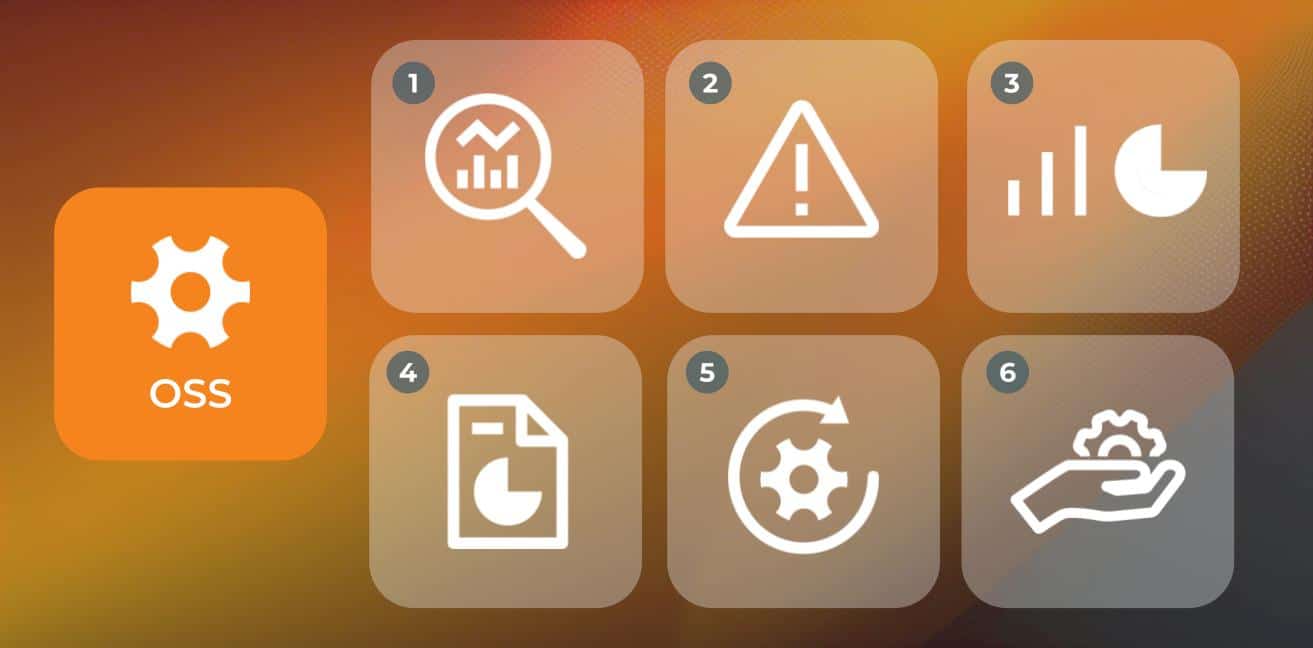
OSS in 5G Networks🔗
In the era of 5G technology, OSS is taking on an even greater level of importance. 5G networks are ushering in unprecedented levels of complexity. Today, we require dynamic resource allocation, dynamic network slicing, and ultra-low latency. (AKA, lots of data volume with little to no delay.) Telecom OSS systems have become instrumental in managing and orchestrating these frankly labyrinthine digital networks, making sure that resources can still be used efficiently, and that services are as integrated as is non-humanly possible.
The Functions of BSS
Ready to launch into our second breakdown in our BSS and OSS set? First, let’s take a moment to switch from that brain metaphor to something a little more boaty. If a telecom was an ocean liner and the customers were the passengers, then BSS would be the cruise director. These systems, in other words, are here to make sure that every aspect of the customer experience flows smoothly. (So that the revenue flows smoothly, too.)
Meanwhile, back to breakdown #2. The key functions of BSS include:
- Customer relationship management via integration with a telecom’s CRM software to manage customer interactions, track preferences, and deliver personalized services.
- Product catalog management to keep track of all of that CSP’s various products and services. It also helps them set the most optimal pricing, and both facilitate and enable the bundling and customization of different products.
- End-to-end order management, all the way from a customer’s first online or assisted order to the delivery of that product or service accurately. (And in good time.)
- Billing and revenue management, including rating, invoicing, payment processing, revenue recognition, and so on.
- Analytics and reporting to provide CSPs with handy insights into customer behavior, market trends, and operational performance. That’s how they make better business decisions.
- Self-service portals are managed by a BSS too, enabling retail and enterprise customers to manage their accounts and services, view and pay bills, and access support resources independently. (Meaning more freedom and efficiency on both sides.)
- Facilitation of partner management and revenue sharing… Yes, our friend BSS even gets involved in helping a telecom collaborate with other businesses to expand their services or reach new markets.
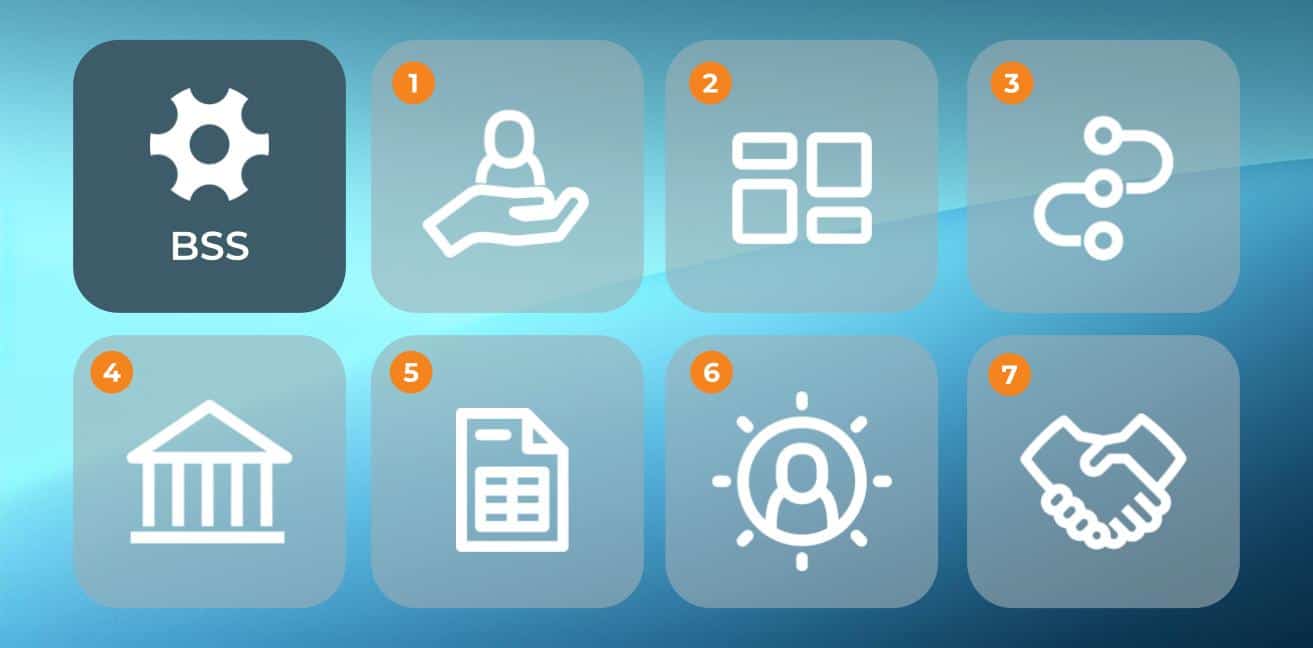
The Growth of BSS and OSS
Oh, is it ever growing. Only a couple of years ago, there were breathless reports of the BSS and OSS market reaching something like US$20 billion by 2022. In fact, it actually reached closer to $50B that year. Now, some analysts are predicting that the BSS and OSS market will hit well over $200B by 2030.
There are a lot of cost efficiencies these converged systems can deliver. Combine that with increased agility, faster scaling, shorter time to market, and increased ability to customize the user experience? Suddenly those added stacks of billions to the initial predictions aren’t such a big surprise.
And there is more to come. Nokia recently laid out a few BSS and OSS related trends and transformations on the horizon that are going to keep fueling that growth in even more. These include digital storefronts; the incorporation of AI into customer service, systems management, and decision-making; automated solution self-configuration and deployment from point of purchase; open APIs (a PortaOne favorite); and a continued movement toward cloud-native and SaaS platforms.
BSS and OSS Beyond Telecom🔗
The impact of these systems have not been confided to telecom either – particularly when it comes to BSS. Business support systems are also having a big role in the e-commerce industry. In fact, they are a crucial part of managing online marketplaces, helping businesses handle order management, inventory tracking, pricing and promotion management, payment processing, and customer support.
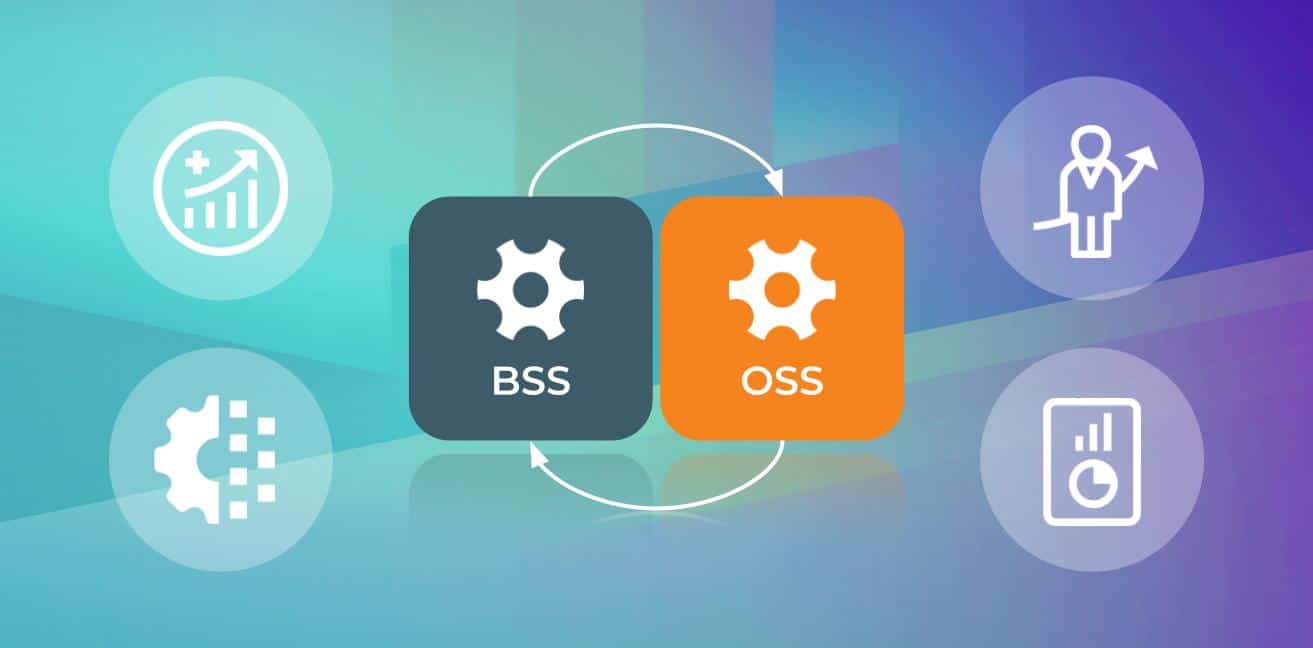
It isn’t taking long for more sectors to catch on to how useful these systems can be in making their operations more efficient and more profitable. Today, BSS and OSS have become instrumental far beyond telecom, in a wide range of corporate business environments. (They are even helping telcos move beyond telco.)
In fact, PortaOne is leveraging these systems right now. We’re using them to reach our influence into SaaS, IoT, datacenters and cloud infrastructure, utilities, EV charging, and more.
Non-telecom businesses that make the decision to adopt BSS and OSS into their operational family are finding a lot of benefits to these telecom-raised siblings:
- Operational efficiency: BSS and OSS can streamline the operations of any tech-involved business, along with automating processes and improving overall efficiency. (Read: cost savings and increased productivity.)
- Enhanced customer experience: By leveraging BSS capabilities, corporate businesses can provide personalized customer experiences, efficient order management, and accurate billing. (Read: improved customer satisfaction.)
- Inventory and resource management: BSS and OSS can enable the effective management of corporate resources, including inventory, assets, and human resources. (Read: more optimization and less waste.)
- Business analytics: Using the data collected by OSS, BSS can provide valuable insights into customer behavior, market trends, and operational performance. (Read: better decisions and better products and services.)
A Few BSS and OSS Transformations in Real (Telecom) Life
Okay, you might be asking. That was a lot of talk, but what about the walk? We have plenty of experience with the effect these systems can have in the real world, too. Or, at least, the real world of telecom operations. So, let’s look at a few examples of how actual PortaOne clients have benefited from these systems.
- Streamlined order management: A PortaOne customer recently used BSS to automate their order management processes and sped up their processing and service activation time by 40%.
- Enhanced customer self-service: Many of our customers are bringing on BSS as a way to allow their end users and enterprise clients to manage their own accounts via a digital portal that allows them to view and pay bills and access support resources. (In other words, self-service.) For one PortaOne customer, this resulted in 20% fewer customer support calls.
- Real-time analytics: Remember those capabilities that allow operators to analyze customer behavior? That’s not just to satisfy curiosity. You can use that data to identify upselling and cross-selling opportunities and personalize your offerings. One of our customers leveraged this to increase their revenue from targeted marketing campaigns by 15%.
- Agile pricing and bundling: A new BSS system allowed another customer to bring in new pricing plans and bundle services that were based on preferences and usage. This resulted in a 30% increase in customer acquisition and retention.
- Faster time-to-market for new features: A new PortaOne customer that had gotten used to waiting up to a year after a request to their previous vendor was amazed to see delivery of new features in just weeks with our cloud BSS platform.
More operational efficiency, knowing your customers better, designing desirable products, and pricing them effectively? That sounds like a pretty good competitive edge.
Are You BSS and OSS Ready?🔗
In short, BSS and OSS are fundamental pillars of the telecom industry (and, yes, beyond). And they are revolutionizing the way CSP operators function, sell, and serve. As the industry continues to evolve – which it never stops doing – these systems will only become more integral in optimizing network performance, delivering customer satisfaction, and finding more profit. So, if you want those things for your telco, BSS and OSS simply has to be on your roadmap.
We hope that a few of these ideas can provide you with some inspiration on how and where to develop these technologies within your own business. If they have, and you’re ready to take the next steps, get in touch with our support team. Our experts can provide you with detailed answers and help you design the right BSS and OSS architecture for your business.
Your BSS/OSS Cheat Sheet
What is OSS? OSS refers to a set of software applications and tools, typically called as group OSS software, that telecommunication operators use to manage and maintain their network infrastructure. The OSS full form is operations support system.
What is BSS? BSS comprises a suite of software applications and platforms, typically called as group BSS software, that handle customer-centric operations and support business processes in the telecommunications industry. The BSS full form is business support system.
An operations support system (OSS) is a set of software applications and tools used by telecommunication operators to monitor, control, and optimize their network infrastructure’s performance, ensuring smooth service delivery to end users.
An OSS network refers to the network infrastructure managed and maintained by an operations support system (OSS). It includes various network elements and equipment that enable the delivery of telecommunications services.
The benefits of using OSS include efficient network monitoring, fault management, performance optimization, streamlined configuration and inventory management, rapid service activation and provisioning, and accurate billing and revenue management.
The benefits of using BSS include effective customer relationship management, streamlined product catalog management, efficient order management, accurate billing and revenue management, self-service portals for customers, data-driven analytics and reporting, and facilitation of partnership and revenue sharing.
Telecom OSS and BSS are together the operations support systems and business support systems used specifically in the telecommunications industry. The OSS systems are responsible for managing and optimizing the performance of network infrastructure, ensuring reliable service delivery to telecom customers. You will also hear these referred to as an OSS platform, OSS software solutions, or OSS applications. BSS systems work with the OSS systems to handle many customer-centric support tasks. Like with OSS, you will also hear these referred to as a BSS platform, BSS software solutions, or BSS applications.

